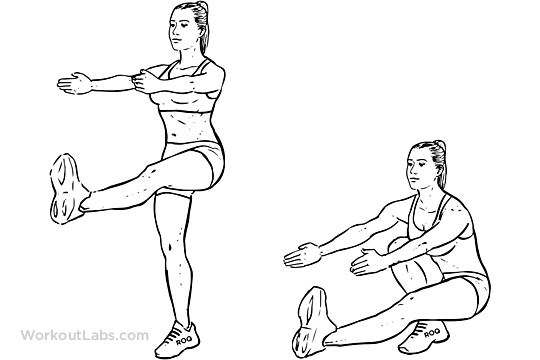In today’s world, we’re pressed for time. Learning how to maximise your physical fitness, by strength training without equipment, may just be one of the best investments you ever make.
Set the Scene
You’re home from work, hoping to find a few minutes to yourself. Feeling an almost suffocating level of responsibility, you sigh at the notion of being able to fit it all in. And then you remember, you’ve got to find time to train.
Normally, this wouldn’t be an issue, but the only half decent gym is a 30 minute drive away. What’s the solution?
You’ll be pleased to know, that this article is the most comprehensive guide to strength training at home, on the internet. It will cover everything you need, from equipment you may need, to ingenious work arounds that stop you having to break the bank.
Grab Your Free Copy of the "Strength Without Equipment" Training Plan
4 Weeks of Progressions - centered around improving your stability and creating a strong, bulletproof structure before laying hands on a barbell.
Note - you'll also receive our exclusive weekly newsletter to help you on your Journey to Strong, once you've received your guide!
Don't worry, there's no spam and you're free to unsubscribe at any time.
CHAPTER ONE – Simple Strength
WHAT?
Learn the topic.
What is Strength?
Before we figure out “how” to build strength at home, we first need to identify what strength truly is and the mechanics of how to improve it.
In the research, strength is defined as the ability to produce force with a magnitude, rate and direction (12, 13).
Another way to think of it is:
Strength is tension/force, produced against a resistance, in a set movement pattern.
Tension is a state brought about from electrical activity within a muscle that is either voluntary (i.e. lifting a weight) or involuntary in response to external stimuli (imagine when you touch something too hot and pull your hand away).

The Stronger a Person Is…
The More Tension They Can Create…
The More Force They Can Produce…
Usually resulting in more weight being lifted.
It’s that simple.
The next question – what movements do we need to be strong in?
Learn More About the Science of Tension
Strength is 8 Movements
Keeping it simple…what movements do we need to be strong in?
ARCHETYPE | EXAMPLE GYM EXERCISES |
|---|---|
Squat | Back Squat, Front Squat, Overhead Squat, Leg Press |
Hip Hinge | Conventional Deadlift, Kettlebell Swing, Romanian Deadlift, Stiff Legged Deadlift |
Vertical Push | Military Press, Overhead Dumbbell Press |
Vertical Pull | Pullups, Pulldowns |
Horizontal Push | Bench Press, Pressups, Dumbbell Press |
Horizontal Pull | Bent Over Row, Pendlay Row, Seal Row |
Lunge/Unilateral Work | Split Squat, Lunge, Pistol Squat |
Loaded Carries | Yoke Walk, Farmers Walk, Loaded Marches |
Quick Word for Isolation Exercises
You may be wondering where isolation exercises, like bicep curls, flys etc. fall into those categories. And that’s a great question:
The answer being – they don’t.
As we’ve spoken about in the “Ultimate Guide to Strength Training for Beginners” – movement comes before muscle.
Isolation exercises serve to develop individual muscles that help contribute to your strength in one of the 8 movements.
Although your strength training at home sessions will include isolation exercises, they will be done with an aim of improving your strength in the squat, hinge etc.
What Is Your Goal?
The final thing we need to clarify before we delve into strength training at home, is your goal.
It goes without saying that the list of benefits to getting stronger are endless – the Prescriptive Layer takes care of what you need….but…
…What are you hoping to achieve through becoming stronger?

But what do you want from training?
Earth Shattering vs. Marathon Running
As amazing as it is too witness the 500kg deadlift, planes being pulled and huge boulders being shifted around – not everyone wants that for themselves.
It’s important to understand that strength is an endless pursuit.
You can literally never be too strong (13).
However, the levels of strength you should strive for are based off:
A) What you need – if you can’t pick your child up off the floor without your back aching for the next few days, you need to get stronger
B) What you want – If you want to break world records, that’s going to look completely different to someone who wants to get stronger to be better at running or getting stronger to help lose weight.
How Do We Know You’re Stronger?
Strength has long been measured as “weight on the bar”.
Whether it’s in the deadlift, bench press or squat – the weight tends to be the only thing that matters to most.
But what about gymnasts? Being able to hold the “Iron Cross” is arguably one of the most impressive feats of strength the human body can perform…but they might not be able to deadlift 2.0x their bodyweight. Does that mean they aren’t strong?
Or what about Alex Honnold, World Record Breaking, Free Solo Climber who scales mountains with no ropes or supportive equipment – I think it would be difficult to argue that he isn’t strong.
Remember, as we said earlier…when it boils down to it – strength is simply tension resulting in force.
Manage What You Choose to Measure
Using barbells and weights is the most common form of measurement because it’s the easiest to standardize across everyone.
A 20kg plate, will always weigh 20kg. So you either lift it, or you don’t. That’s what attracts so many people to that form of strength training and ultimately, what makes it so effective.
However, when strength training at home, you might not have access to an endless supply of weights but that certainly doesn’t mean that you’re at a loss and doesn’t mean you need to buy some small 3kg dumbbells and swear yourself to a life of endless high rep “toning” work – so it’s time to get savvy and build strength in a myriad of different ways.
Strength has long been measured by weight on the bar...but it's hard to deny the strength of gymnasts, climbers and everyone else who doesn't produce force against the iron. It's time to rethink what constitutes strength.
CHAPTER TWO – Why Strength Without Equipment is Possible
WHY?
Learn the science and theory.
Laws of Physical Training
Now that we understand the simplicity of strength it’s time to break down the training process.
Consistent, Component Specific Progression best suited to the Individual.
Law 1 – Consistency = If you are strength training at home, then you really have no excuse when it comes to consistency. Finding 30 minutes, 3-4 times a week should be manageable for absolutely everyone. If not, you need to re-think your routine.
Law 2 – Specificity = As we’ve just discussed above, building strength requires the ability to generate tension against resistance, not always about lifting more weight.
Law 3 – Progression = Through this guide, we’ll show you how to progress all forms of strength training, from bodyweight to isometric training.
Law 4 – Individuality = Do what is needed, choose what you enjoy.
Where Current “Strength Training at Home” Programs Go Wrong
There are hundreds, thousands, endless recommendations on how to include strength training without equipment.
As valuable as they are to the beginner and useful to the advanced trainee who is looking to cram in more work at home, programs based off simple strength training at home tend to fall short in a few areas:
1) Lack of Intensity –
Strength is formed from intensity = The percentage of your maximum output. The closer you get to the 100% effort, the stronger you become.
There is a lot to be said for training volume and making sure you train often enough to invoke adaptation, but there is a minimum intensity threshold you have to hit for the body to increase in strength.
A lot of the recommendations of how to include strength training without equipment fall short on intensity – suggesting that resistance bands, light dumbbells and your bodyweight is enough.
Bodyweight squats will make you stronger, improve movement and flexibility – there are several benefits… But they only help at the beginning. Which leads us to our next downfall:

2) Lack of Progression
Bodyweight squats help at the beginning. When you’re new to exercise or strength training, even walking uphill will improve your lower body strength if you’re weak enough (1).
Eventually however, through the Law of Accomodation, your body won’t adapt to the initial stimulus anymore.
As the Law States – you’ve got to make it harder.
And adding repetitions isn’t enough.
Being able to do 100 consecutive bodyweight squats is a pretty high level of fitness – in other words, you could continue to add on rep after rep until you reach this goal.
But it won’t translate over to your maximal strength.
The Science of Overload
Many people are unaware of the simplest concept in physical training – You’ve got to do more, to gain more.
Sounds simple, right?
Well…not quite.
You see, the body is only capable of adapting to what it can effectively recover from. Despite how people struggle with motivation, most people surprise themselves with how much they can actually do when pushed to the limits. What you’re capable of doing and what your body can handle are, unfortunately, different things.
In other words, just because you can do more, doesn’t mean you should.
Now, when it comes to strength training without equipment – this actually works in our favour.
Journey of a Thousand Miles…
As the saying goes – The Journey of a Thousand Miles begins with a single step.
And it’s completed, one step at a time.
In today’s society, we want everything instantly. Whether it’s binge watching your favourite TV show on Netflix, or ordering with 24 hour delivery, we’ve lost touch with one of the greatest virtues one can possess – patience.
If you’re a beginner, strength training without equipment can actually be a huge blessing in disguise – you’ll be forced to place the emphasis on the variables that matter:
- Learning correct movement
- Understanding leverages and how to generate tension.
- Building a foundation of work capacity (i.e. moving more)

What about Advanced Trainees?
If you’re experienced in the world of strength, then you might think that strength training without equipment is a pointless endeavour.
You need bars and stones to make you strong…flipping tires and throwing kettlebells to build your conditioning and explosiveness…what’s strength training without equipment going to achieve?
Ask yourself the following questions:
Can you perform a Single Leg Romanian Deadlift?
Can you sit in the bottom of a squat for 40-60 seconds without pain developing?
How strong is your Core?
There are always things you can be working on to maximise your strength.
Squats, deadlifts and everything in between are 80% of effective training – but there’s always the 20% that you need to work on.
Most of that doesn’t actually need equipment.
The Science of Movement
It’s a huge misconception that strength revolves around muscle.
As a matter of fact, studies have attributed only 50% of short term strength gains to increase in muscle size (9).
Research has shown that increases in muscle size can be similar with both high and low load training regimes, provided the volume/time under tension is equal (8, 10).
Strength however? There is disparity.
High “load” (A.K.A High Intensity) training trumps low “load”, producing significantly greater improvements in strength, every single time (6).
The Nervous System
This is because muscle mass only provides a platform for more force to be produced.
Just because you have the potential to be stronger, doesn’t mean you will be.
There are 3 Main Variables that describe how the Nervous System influences our strength:
1. Motor Unit Recruitment
Hennemann et al. (5) discovered that motor units (series’ of muscle fibres bundled together and activated by the nervous system) are recruited in a sequential manner.
The smallest motor units are called upon first, for the easiest tasks and the larger ones only get involved if the task becomes more intense.

Think of it as your body’s intrinsic, innately designed, “lazy” mode – it’s all in a bid to save energy.
The important thing to note is the the type of (and goal) of the activity not only directly affects which motor units are recruited…but how they adapt (3, 14).
Forging Relative Strength
This why less muscular people can still display some of the greatest feats of strength you will ever see. Head here to read the Guide to Forging Relative Strength.
2. Rate Coding
This refers to the frequency at which each motor unit activates (not just the size). Research has shown that the force produced in a movement may increase by 300…to 1500% when the firing frequency goes from minimum to maximum (4).
3. Motor Unit Synchronisation + Intermuscular Coordination
This essentially refers to the coordination of all motor units to fire, at the right time, in the right order.
And it’s one of the biggest determining factors between the elite and untrained individuals (11).
So what does this mean?
Stronger…Or…Better?
A huge aspect of strength is the skill of the individual.
How efficient you are during a movement (also known as “technique”), has been found to be one of the key distinguishing factors between novice and elite lifters (7).
Now let’s not be naive, your technique in a back squat won’t be as proficient using just your bodyweight, as it will be when you finally touch the iron and get to work.
Be that as it may, learning how to move and control your body position, improve your stability/mobility and all the other factors that go into efficient technique can all be worked on, without virtually any training equipment.
CHAPTER THREE – The “How” of Strength Training Without Equipment
HOW?
Learn the implementation.
1. Calisthenics – Mastering Leverage to Build Strength
Calisthenics, originating from the Greek words kallos (κάλλος), meaning beauty (emphasising aesthetic pleasure from the perfection of the human body) and sthenos (σθένος), meaning “strength” (great mental strength, courage, strength and determination) – refers to the development of the human body using only bodyweight exercises.
Referring to our earlier section, what is your goal of strength training?
Specificity is a huge element of the training world – being the 2nd Law, you need to make sure you adhere to it.
And for most people, getting strong is simply about being able to control their own body position – combatting the negative imbalances brought on by life, or to meet the demands of the physical activities they perform such as playing with their kids.
In this context, bodyweight training is incredibly effective.
Keeping Progression in Mind…
The main hurdle people come across when getting strong through calisthenics is a lack of progression. As we stated earlier, in order to provide overload, we have to do more than simply adding more repetitions.
This is where you have to get creative.
Understanding leverage is the easiest way to make an exercise harder, shift the emphasis from one muscle to another and ultimately create a well-balanced, strong physique.
Let’s take the pullup for example.
Almost everyone would agree that a narrow hand placement on a pullup is much easier than a wider hand position.
And this is simply due to the amount of torque required at the shoulder joint.
Understanding leverage is the easiest way to make an exercise harder, shift the emphasis from one muscle to another and ultimately create a well-balanced, strong physique.
Go Single Limb…
Another easy way of progressing from one exercise to a much harder version – is to perform it using one leg.
Let’s take the squat as an example – The following progression, is a simple and incredibly effective way of strength training without equipment.

Squat

Split Squat

Single Leg Squat

Pistol Squat
2. Isometrics
Arguably the most effective method of building maximal strength – and the core component of our Unshakable Strength Protocol – isometrics are an incredibly valuable tool when building strength without equipment.
All you need, is an object that won’t move when you apply force against it.
This can be a solid wall, a fixed bar or a simple set of straps that you can stand on, hold and pull against.
A perfect example of this can be seen in the isometric deadlift –
You also don’t have to have a fixed resistance – you can simply…pause…during an exercise.
For example, the body weight pressup can become relatively easy for most, once you overcome the hurdle of being able to perform it in the first place.
Pausing in the bottom phase of the movement (1-2″ off the ground) and holding it for a certain length of time is a great way of providing overload and maximising tension within the movement.
3. Weak Point Training
Weak muscles cause imbalances. And that’s not a good situation for health or athletic performance.
To add to that, weak muscles often can’t be targetted with heavier strength training anyway. They simply switch off and other muscles compensate as a result.
So, we can actually use this to our advantage, particularly in the earlier stages of correcting any imbalances that might be present.
Let’s take the following muscles:
- Transverse Abdominis (A.K.A “Deep Core”) – Responsible for Lower Back Pain/Control and Pelvic Stability.
- Glute Medius – Responsible for Lumbo-Pelvic Control, Knee Position in the Squat etc.
- Serratus Anterior (A.K.A “The Boxer’s Muscle”) – Responsible for Shoulder Stability and Control.
All of those muscles can be trained and improved with simple, body weight exercises – Just click the links to the exercises below.
MUSCLE TRAINED | EXERCISE | SETS & REPS |
|---|---|---|
Transverse Abdominis | 3 sets of 6 each side | |
Glute Medius | 3 sets of 10 each side | |
Serratus Anterior | 3 sets of 8 |
4. Ballistic/Explosive Movement
Now, strength is great. However, most of the benefits we receive from strength that manifest themselves in daily life, come with some pre-determined speed or “time limit”.
Force being expressed with a given velocity is also known as “power” = the rate at which work is done.

And fortunately, we can train the velocity end of the spectrum with virtually no equipment at all.
To add to that, in the same way motor units are recruited in size order based off the weight lifted, the same is true with lighter loads that need to be moved rapidly (2).
In other words, you can also train fast, to improve help improve your strength.
Top End Sprinting (Advanced), Jumping, Plyometric Training and Explosive Upper Body Movements (e.g. throwing).
Combinations Of Training
So how does this all tie in? Which forms of training focus on building the nervous system which can help develop strength and which areas fall short? Which forms of training are effective methods of strength training without equipment?
Heavy Loads, Slow Speed = Power-lifting, Advanced Calisthenics, Isometric Training
Light Loads, High Speed = Sprinting, Jumping, Throwing
Heavy Loads, High Speed = Olympic Weightlifting
Lighter Loads, Slow Speed = Bodybuilding, Circuit Style Training, Cardio
CHAPTER FOUR – Example Training Plan
Freedom of Strength
In our newest product “The Unshakable Strength Protocol” – we have created a Freedom of Strength Variation.
This is the greatest example of how to adjust the exercises that you would typically perform within the gym – with no equipment whatsoever.
We’ve also included a “Key” System – showing you how each exercise is linked, so you’re able to mix and match between gym programs and training that may be more suitable for you logistically.
THE UNSHAKABLE STRENGTH PROTOCOL
Head here to gain access to our Brand New Training Program -
The Unshakable Strength Protocol
Summary
- Although you certainly won’t break the world record deadlift without a barbell, having access to the latest equipment shouldn’t present itself as a barrier to strength training.
Strength training without equipment focuses heavily on developing the following skills:
- It can help to improve some of the neurological aspects of strength (such as rate coding and intermuscular coordination), provided they are done correctly.
- Strength training without equipment needs progression and methods that achieve the intensity you need.
Strength training without equipment can be done in a few different ways:
Strength training without equipment is a perfectly feasible method of developing your physical fitness and helps to create the foundation for more advanced forms of training in years to come.
Don’t let the lack of equipment stop you.
Get after it and start getting strong now.
References
- Brown, M., & Holloszy, J. O. (1993). Effects of walking, jogging and cycling on strength, flexibility, speed and balance in 60-to 72-year olds. Aging Clinical and Experimental Research, 5(6), 427-434
- Desmedt, J. E., & Godaux, E. (1977). Ballistic contractions in man: characteristic recruitment pattern of single motor units of the tibialis anterior muscle. The Journal of physiology, 264(3), 673-693
- Duchateau, J., Semmler, J. G., & Enoka, R. M. (2006). Training adaptations in the behavior of human motor units. Journal of applied physiology, 101(6), 1766-1775
- Enoka, R. M. (1995). Morphological features and activation patterns of motor units. Journal of clinical neurophysiology: official publication of the American Electroencephalographic Society, 12(6), 538-559
- Henneman, E., Somjen, G., & Carpenter, D. O. (1965). Excitability and inhibitibility of motoneurons of different sizes. Journal of neurophysiology, 28(3), 599-620
- Jenkins, N. D., Miramonti, A. A., Hill, E. C., Smith, C. M., Cochrane-Snyman, K. C., Housh, T. J., & Cramer, J. T. (2017). Greater neural adaptations following high-vs. low-load resistance training. Frontiers in physiology, 8, 331.
- Miletello, W. M., Beam, J. R., & Cooper, Z. C. (2009). A biomechanical analysis of the squat between competitive collegiate, competitive high school, and novice powerlifters. The Journal of Strength & Conditioning Research, 23(5), 1611-1617
- Mitchell, C. J., Churchward-Venne, T. A., West, D. W., Burd, N. A., Breen, L., Baker, S. K., & Phillips, S. M. (2012). Resistance exercise load does not determine training-mediated hypertrophic gains in young men. Journal of applied physiology, 113(1), 71-77
- Narici, M. V., Roi, G. S., Landoni, L., Minetti, A. E., & Cerretelli, P. (1989). Changes in force, cross-sectional area and neural activation during strength training and detraining of the human quadriceps. European journal of applied physiology and occupational physiology, 59(4), 310-319.
- Ogasawara, R., Loenneke, J. P., Thiebaud, R. S., & Abe, T. (2013). Low-load bench press training to fatigue results in muscle hypertrophy similar to high-load bench press training. International Journal of Clinical Medicine, 4(02), 114
- Semmler, J. G., & Nordstrom, M. A. (1998). Motor unit discharge and force tremor in skill-and strength-trained individuals. Experimental Brain Research, 119(1), 27-38
- Siff, M. (2000). Biomechanical foundations of strength and power training. Biomechanics in sport, 103-139
- Stone, M. H. (1993). Position statement: Explosive exercise and training. Strength & Conditioning Journal, 15(3), 7-15
- Van Cutsem, M., Duchateau, J., & Hainaut, K. (1998). Changes in single motor unit behaviour contribute to the increase in contraction speed after dynamic training in humans. The Journal of physiology, 513(1), 295-305





